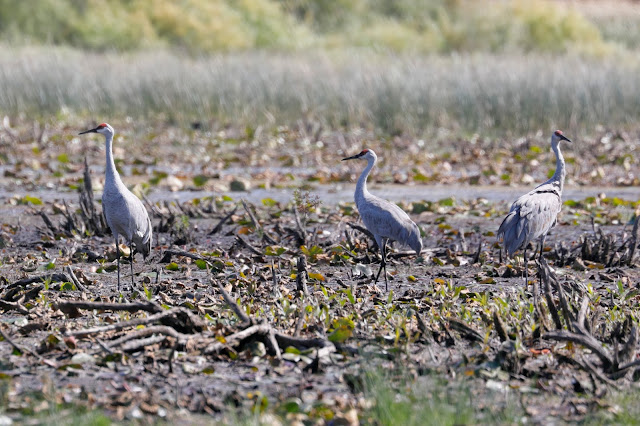27 September 2016
A couple of people have been bugging me for a while about starting a regular weekly outing of local areas taking up all or part of the morning. Finally, I succumbed to their entreaties and our first session was primarily to Bannister Lake in Cambridge, ON, where at this time of the year Sandhill Cranes Grus canadensis feed at the edge of the lake, sometimes in large numbers. A little side trip to Grass Lake rounded out the morning.
Miriam and I were joined for this excursion by Franc Gorenc, Mary Voisin and Judy Wyatt. Although anyone who wishes to attend will always be welcomed, a small group like this is very manageable.
Franc is a fine photographer with a range of excellent equipment, and he has kindly given his consent for me to use his pictures for this blog post.
We did not see large numbers of Sandhill Cranes, but we were not disappointed in our quest for this impressive species. They heralded their arrival with loud bugling, a sound which sends shivers up my spine, and they landed in small groups on the far side of the lake.
Quickly they settled into a feeding routine, periodically stopping to dance energetically. Since breeding has finished for the year one can only assume this behaviour represents some kind of reinforcement bonding; it certainly presented fine entertainment for us.
Sandhill Crane is an exceedingly handsome species and we are very fortunate to have them in our area.
In addition to the show put on by the cranes we had the good fortune to have a Western Osprey Pandion haliaetus circling the lake in front of us, finally diving to catch a fish and coming up with its prize. It is an impressive and memorable encounter; even though I have witnessed it many times it never ceases to thrill and amaze. I think that Franc has captured it superbly in the following images.
The powerful down stroke of those huge wings lifts the bird out of the water and it turns the fish face forward to provide aerodynamic efficiency, and flies off with its prize. Ospreys will be migrating south very soon now, in fact some have already departed, so we were fortunate to enjoy this spectacle. The memory will warm us on a cold winter's night.
By carefully scanning the water we discovered numerous species of waterfowl, including a sizable number of Wood Ducks Aix sponsa, the males in their finery, glinting in the early morning sun.
There were many Great Blue Herons Ardea herodias present; if they came too close to the Sandhill Cranes they were unceremoniously driven off - no doubt all part of learning to cope with life for this young bird.
The number of Pied-billed Grebes Podilymbus podiceps was quite astounding and we all commented on the abundance of this species.
At a casual glance grebes seem to be wedded to the water and are seldom seen to fly. As a migratory species, however, they obviously cover long distances and it was entertaining to see these birds making short bursts of flight across the lake, no doubt preparing for the long journey ahead.
In the woods surrounding the lake Blue Jays Cyanocitta cristata were in evidence, both resident and migratory populations.
The old expression "familiarity breeds contempt" might never be more true than as it relates to Blue Jays. This stunningly handsome bird is barely given a passing glance due to its familiarity, but it is worthy of all the adulation we can give it.
A short journey over to Grass Lake produced numerous delights, including many Eastern Meadowlarks Sturnella magna and a couple of Eastern Bluebird Sialia sialis. This is a male perched on a wire.
It was a very agreeable way to spend a morning, with great companions, and I am looking forward to the next time.
In the woods surrounding the lake Blue Jays Cyanocitta cristata were in evidence, both resident and migratory populations.
The old expression "familiarity breeds contempt" might never be more true than as it relates to Blue Jays. This stunningly handsome bird is barely given a passing glance due to its familiarity, but it is worthy of all the adulation we can give it.
A short journey over to Grass Lake produced numerous delights, including many Eastern Meadowlarks Sturnella magna and a couple of Eastern Bluebird Sialia sialis. This is a male perched on a wire.
It was a very agreeable way to spend a morning, with great companions, and I am looking forward to the next time.














































































.jpg)
